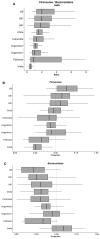The Firmicutes/Bacteroidetes Ratio: A Relevant Marker of Gut Dysbiosis in Obese Patients? - PubMed (original) (raw)
Review
The Firmicutes/Bacteroidetes Ratio: A Relevant Marker of Gut Dysbiosis in Obese Patients?
Fabien Magne et al. Nutrients. 2020.
Abstract
The gut microbiota is emerging as a promising target for the management or prevention of inflammatory and metabolic disorders in humans. Many of the current research efforts are focused on the identification of specific microbial signatures, more particularly for those associated with obesity, type 2 diabetes, and cardiovascular diseases. Some studies have described that the gut microbiota of obese animals and humans exhibits a higher Firmicutes/Bacteroidetes ratio compared with normal-weight individuals, proposing this ratio as an eventual biomarker. Accordingly, the Firmicutes/Bacteroidetes ratio is frequently cited in the scientific literature as a hallmark of obesity. The aim of the present review was to discuss the validity of this potential marker, based on the great amount of contradictory results reported in the literature. Such discrepancies might be explained by the existence of interpretative bias generated by methodological differences in sample processing and DNA sequence analysis, or by the generally poor characterization of the recruited subjects and, more particularly, the lack of consideration of lifestyle-associated factors known to affect microbiota composition and/or diversity. For these reasons, it is currently difficult to associate the Firmicutes/Bacteroidetes ratio with a determined health status and more specifically to consider it as a hallmark of obesity.
Keywords: Bacteroidetes; Firmicutes; Microbiota; dysbiosis; gut; marker; obesity.
Conflict of interest statement
The authors declare no conflict of interest.
Figures
Figure 1
Variability in the Firmicutes/Bacteroidetes ratio (A) and the relative abundances of Firmicutes (B) and Bacteroidetes (C) in the gut microbiota from several healthy populations. Box plots were constructed using R. In the box and whisker plots, the line shows the median; the box, the interquartile range; and the whiskers, the highest and lowest values.
References
Publication types
MeSH terms
Substances
LinkOut - more resources
Full Text Sources
Medical
